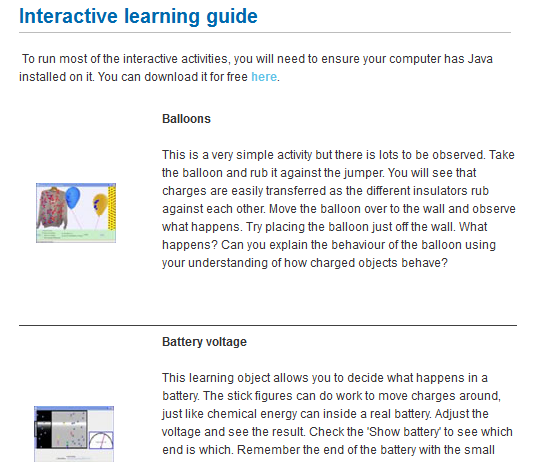Los recursos seleccionados para trabajar la unidad "Electricity" que os mostré en tablero Symbaloo de una entrada anterior están clasificados en función de sus objetivos de uso tal y como podéis ver a continuación:
INTRODUCIR EL TEMA. Para abordar el tema se utilizarán los siguientes vídeos y animación con el fin de que los alumnos se familiaricen con los conceptos que se van a utilizar.
Electricity and circuit
ENTENDER VOCABULARIO Y CONTENIDO. El siguiente recurso presenta el vocabulario principal del tema para que posteriormente puedan entender las explicaciones.
PRACTICAR VOCABULARIO. Este recurso presenta flashcards con cuestiones acerca del vocabulario introducido anteriormente.
COMPRENDER ANALIZAR. Los siguientes recursos son experimentos y actividades interactivas que pondrán en práctica lo explicado en la teoría para poder comprenderla mejor.
AMPLIAR Y REPASAR CONTENIDO. Finalmente se plantean los siguientes recursos con el fin de repasar los contenidos y afianzar lo aprendido

DISEÑO DE MATERIALES
Por otro lado también se han adaptado algunos materiales para utilizar como apoyo en las clases. Se muestran a continuación:
1. Los
textos para abordar la unidad serán los que muestran las siguientes webs. Los alumnos serán conducidos en su
lectura y se les ayudará a extraer la información más relevante.
http://www.eia.gov/kids/energy.cfm?page=electricity_science-basics#top-container
El vocabulario se presentará con el siguiente recurso (ANDAMIAJE DE RECEPCIÓN)
http://www.learningcircuits.co.uk/flashmain.htm
http://www.switchedonkids.org.uk/docs/teachers-resources/SwitchedOnKids_Poster.pdf
Activity
1: Heat, light and
motion. Electricity Scavenger Hunt (ANDAMIAJE DE TRANSFORMACIÓN)
The intent of this activity is for students to understand how electricity is
used in their everyday lives. It helps them connect the theory they will learn
about electricity to its practical applications
Answers to questions: 1. A toaster obviously converts electricity to heat energy, but what makes the toast pop up? Is that electricity too?
(There is a mechanical part within the toaster that allows the toast to pop up. This part is triggered by the elements in the toaster.)
2. Most cars run on gasoline, but there are lots of electrical parts to cars, too. Where does the electricity come from to run things like the headlights and the radio?
(The battery gets charged by the engine.)
3. Some ovens use electricity converted into heat energy to cook food. What kind of energy do non-electric ovens and stoves use?
(Gas)
4. What about the computer you're using right now? Does it use electricity for heat, light and motion, too? All three?
(The computer exhibits all three. e.g., there is a fan in the box which exhibits motion, the monitor emits light, and both the monitor and computer chips emit heat.)
Activity 2: The day the lights went out (ANDAMIAJE DE PRODUCCIÓN)
The intent of this activity is for students to realize the importance of electricity in their daily lives. Let students have some fun with this skit activity. It will definitely make them more interested in learning how electricity works.
Activity 3: What is a circuit? (ANDAMIAJE DE TRANSFORMACIÓN)
http://www.switchedonkids.org.uk/docs/teachers-resources/SimpleCircuit.pdf
Activity 4: El siguiente ejercicio es una sopa de letras para repasar el vocabulario (ANDAMIAJE DE RECEPCIÓN)
Activity 5:
Listening. Una canción con la palabra electricity y en la que deberán identificar
cualquier palabra que se pueda utilizar al hablar de electricidad. Estas
palabras se clasificarán en sustantivos, adjetivos y verbos. (ANDAMIAJE DE
TRANSFORMACIÓN)
http://www.lyricsgaps.com/exercises/view/2853/Karaoke
3. Diseño de materiales interactivos.
Siempre me ha gustado diseñar las actividades para mis alumnos pero con las nuevas herramientas que tenemos a nuestra disposición podemos conseguir que esto sea aún más atractivo, los resultados llegan a ser espectaculares. Esta vez he utilizado la nueva herramienta que nos han presentado en el curso, EDUCAPLAY y puedo decir que ya la he incorporado a la lista de mis favoritas. Os muestro dos actividades para que veais el resultado.
2. MULTIPLE CHOICE
Os animo a probar Educaplay es muy fácil de utilizar.









